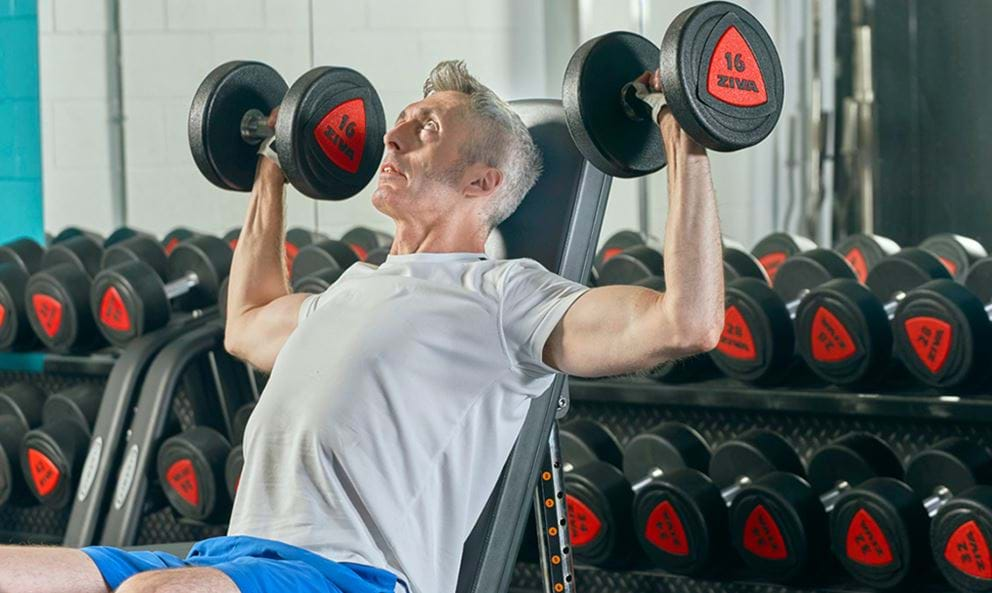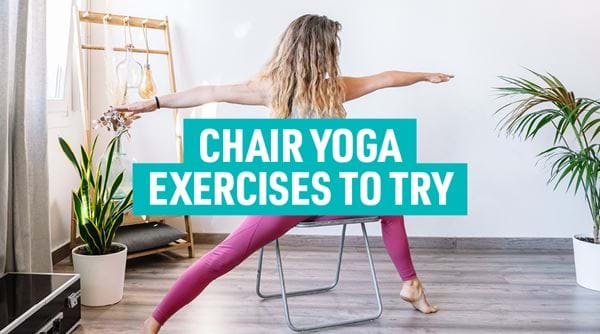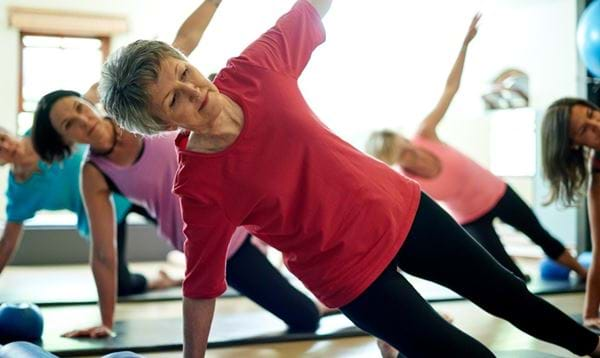Arm Workouts for Seniors – at Home or in the Gym

As we get older, fitting regular exercise into our lives can seem a daunting or exhausting prospect. However, not all exercise needs to involve hours on a treadmill or lots of high impact cardio. Working on exercises to improve your balance is a great place to start, and once you've built up some strength a well-rounded weekly exercise routine (find out more about that in our Exercises for Older Adults guide) will do wonders. You can also see huge benefits from focusing on strength boosting movements that target specific areas of your body.
Here we’ll focus specifically on arm workouts, including why they’re so important as you get older, and what types of exercises you can do.
What are the benefits of arm workouts for older adults?
Featuring arm workouts as a part of a wider fitness regime can play a supporting role in keeping good posture, bone density, and strength and also support in carrying out daily activities such as carrying heavier objects.
Examples include:
- Improved strength – it’s an obvious benefit, and also a particularly good one. By strengthening the muscles in your arms you’ll be able to lift items more easily, pull things down from high shelves and even raise yourself out of an armchair more comfortably. You’ll see the benefits in every day movements, such as pushing a shopping trolley, opening heavy doors, shifting furniture to vacuum or even twisting open a stuck jar.
- Better mobility – if you find your shoulders, elbows or wrists feeling tight, then stretching and strengthening your arms regularly can help to ease discomfort, prevent muscle loss and keep you functioning as smoothly as possible[1].
- Reduces chance of injury – as we get older, our bodies can become more fragile and susceptible to injury. By strengthening your joints and muscles, they’ll be sturdier and less likely to be damaged.
- Toning and shaping – a popular question we hear from gym-goers of all ages is ‘will arm workouts tighten flabby arms?’ Well, while there’s no quick-fix to specifically target arm fat, by working out to control your weight and including a variety of arm-focused exercises, you’ll be likely to significantly tone and sculpt the appearance of your upper arms, as well as your shoulders and even your back. As you lose weight, you’ll reveal all the firm muscles you’ve been building through your workouts.
[1] https://www.ncbi.nlm.nih.gov/pmc/articles/PMC3117172/
What counts as an arm workout?
Depending on your current fitness levels, any extra weight or activity for your arms could count as a workout of sorts, from carrying heavy grocery bags to picking up a pet. However, in order to prevent injury, we recommend controlled workouts where you carefully pick a weight that works for you.
For some workouts, this could be holding your own body weight, using resistance bands or even taking a can of beans in each hand. Then, of course, there’s a variety of weights equipment at the gym that can help to target your arms, from free-weights like kettlebells and dumbbells, to cable pulls and heavier barbells. Find a weight and a movement that challenges you, without straining your muscles too hard – you don’t want to cause an injury by pushing yourself too hard, too fast.
What muscles should you be working?
The muscles in the upper arm have an effect on the movement of your shoulders and elbows, helping to bend and flex the forearm.
The three main muscles you’re likely to focus on in your work outs are the:
- Biceps – large upper arm muscles that controls the motion of the shoulder and elbow, helping to flex and turn the forearm. Essential for lifting, pulling and pushing, and one of the key muscles to target for toned, shapely arms.
- Triceps – the large muscle in the back of the upper arm, it helps to straighten your arms, pull the upper arm towards the body and pull the upper arm backwards.
- Deltoids – these make up the bulk of your shoulder muscles, and are the key to any movement of your arm away from your body. These allow you to carry objects at a safer distance from your body and can stop dislocation and injury to the humerus (upper arm bone).
The best arm workouts for seniors
We’ve tried to include a variety of options here, which we hope will be suitable through your senior years whether you’re a beginner, or maintaining an existing exercise regime. Most of these can be done at home or at the gym, using light weights or even weighted items from around your home like tins or water bottles. If you find that too challenging, feel free to complete the movements without any additional weight or resistance. You can build up to weights, or even heavier weights, as you get more practised with the motion.
Start by completing each arm movement (which is known as a ‘rep’) 10 times before taking a 30 second rest and repeating for another 10. Each round of 10 reps is a ‘set’ and we recommend 3 sets of 10 reps as a starting point for each exercise below. If you’re finding this too strenuous, you can lower the number of reps within each set or increase your rest time – whichever you are most comfortable with.
- Wall slides: This exercise can easily be performed at home and can be a great exercise to help improve mobility and flexibility of the shoulders. To perform the exercise, lean with your back flat against a blank wall. Raise your elbows to the sides of your body at a 90 degree angle with the back of your hands lightly touching the wall. Squeeze your back muscles as you glide your arms vertically overhead whilst maintaining a slight bend in the elbow. Pause. Slide your arms back down to starting position by focusing on squeezing the back muscles as you do this. Perform 8-12 reps. Take a 30 seconds break and repeat.
- Shoulder press: Strengthen your shoulders by using a set of dumbbells in the gym or water bottles at home to use as weights. You can perform this exercise seated or standing - choose whichever is most comfortable for you. Holding an equal weight in each hand, bring your weight at shoulder height with your elbows at a 90 degree angle. Slowly lift the weight above your head whilst keeping a slight bend in the elbows. Pause then slowly lower the weights back to starting position. This counts as one rep. Perform about 6-12 reps using a weight that is appropriate for you. It should feel slightly challenging but it should not compromise your form. Rest for 30 seconds to a minute and repeat 3 times.
- Incline push up: This is a great bodyweight exercise that works your arms and chest. Find an appropriate surface such as a sofa or workout bench that won't move when performing this exercise. Place your hands slightly wider than shoulder width apart on a bench with your feet planted on the floor. Brace your core so your body is in plank position. Keeping this nice braced position and lower your chest towards the bench as you bend your arms. Push your body back up to starting position using the strength of your arms. Perform about 5-10 reps. Take a minute rest and repeat 2 times.
- Seated cable rows: These require the cable machine at the gym (find out more about the cable machine here). You’ll find they’ll help to strengthen your back muscles, as well as your forearms, biceps and triceps, although you’ll also feel benefits in your core. Sit on the cable machine with a straight back and knees slightly bent. Grab hold of the handle with both hands and straight arms, and pull the cable in towards your ribs, keeping a straight back. Pause, while squeezing all your muscles, and slowly return the cable back to starting position. Perform 8-12 reps. Take a minute rest and repeat 3 times.
- Bicep curls: As the name would suggest, these are great for strengthening your bicep muscles. You’ll be using these for all manner of common movements throughout the day without even realising, every time you use your arms to push, pull or lift. Start either in a seated position (on a workout bench or a chair with no arms) or stood up and, ideally, with a light weight in your hand (although start without if you’re unsure). Focusing on one arm at a time, start with your arm hanging straight down towards the floor from your shoulder with the fingers of your hand facing your body. Keeping your shoulders back, gently bend your elbow upwards towards your body, twisting your wrist so your fingers end up facing your shoulder. Pause, before returning to starting position. See a video and more detailed explanation in our How to Bicep Curl guide. Perform 8-12 reps. Take a minute rest and repeat 2 times.
This is just an example arm workout that you might find useful. You can find plenty more ideas in our Arms and Shoulder Workouts hub. You can check out our other exercise guides for seniors, including seated exercises for seniors here, and balance exercises for seniors here. We've also shared some of the best back strengthening exercises for seniors, which can help to reduce back pain.
If you're not quite ready for weight specific workouts, improving your balance is a good first step.
*Before embarking on a new exercise programme, please consult with a Doctor or qualified professional.


